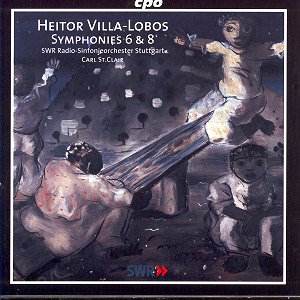 Composer: Heitor VILLA-LOBOS (1887-1959)
Composer: Heitor VILLA-LOBOS (1887-1959)
Works: Symphonies No. 6, ‘Sobre a linha das Montanhas do Brasil’, No. 8; Suite pour cordes
Performers: SWR Radio-Symphony Orchestra, Stuttgart / Carl St. Clair
Recorded: Stadthalle, Sindelfingen, February 17th-21st, 1997; April 18th, 2001
Label: CPO 999 517-2
Duration: 69:20
In this captivating release from CPO, conductor Carl St. Clair leads the SWR Radio-Symphony Orchestra through a compelling traversal of two of Heitor Villa-Lobos’s symphonic works, along with an earlier chamber piece, the Suite pour cordes. This recording serves not only as a testament to the enduring richness of Villa-Lobos’s oeuvre but also as a reminder of the underappreciated treasures within the 20th-century canon.
Villa-Lobos is an artist whose musical language is as multifaceted as the landscapes of his native Brazil. The Sixth Symphony, subtitled ‘Sobre a linha das Montanhas do Brasil’, exemplifies the composer’s distinctive ability to weave geographical inspiration into sonic form. Here, the contours of the Serra dos Órgãos mountain range are translated into melodic lines, resulting in a work that oscillates between the concrete and the abstract. The rhythmic vitality of the first movement, characterized by syncopated motifs, exudes a vibrant energy that is infectious. St. Clair’s deft handling of the orchestra allows these rhythms to shine, drawing the listener into a sound world both vigorous and alluring.
However, it is the second movement, marked ‘Lento-Adagio’, that reveals the depth and complexity of Villa-Lobos’s vision. This movement, shrouded in a nocturnal atmosphere, evokes a sense of introspection reminiscent of Bartók’s night music, albeit with a distinctly South American flavor. The scoring here is particularly noteworthy; the interplay between the trumpets and high violins creates a magical soundscape that lingers in the mind long after the music has ceased. It is a testament to St. Clair’s interpretive insight that he allows these textures to unfold naturally, enhancing the movement’s inherent poignancy.
The final movement, while more diffuse and less cohesive than its predecessors, offers a glimpse into Villa-Lobos’s penchant for cinematic effects, reminiscent of John Williams’s film scores. This segment, while arguably the weakest link in the symphony, does not detract significantly from the overall experience, as the preceding movements have laid a rich groundwork for exploration.
Transitioning to the Eighth Symphony, composed in 1950, we find Villa-Lobos engaging in a dialogue with the past, notably invoking echoes of Schubert’s Ninth Symphony. The thematic material bears a resemblance that is both intentional and serendipitously discovered by the listener, with the first movement radiating warmth through lush harmonies and playful motifs. Here, St. Clair’s interpretation shines, as he balances the orchestral forces with a keen sense of buoyancy, allowing the music to breathe freely.
The second movement, celebrated for its delicate charm, presents a stark contrast to the energetic scherzo that follows. It is in this scherzo that the Stuttgart players are pushed to their technical limits, yet they rise to the challenge, demonstrating commendable agility and precision. The finale, marked by its unpredictability and a sense of joyous playfulness, succeeds in maintaining the momentum established by the earlier movements, concluding the work on a high note.
Accompanying the symphonies, the Suite pour cordes from 1912/13, though less well-known, offers a glimpse into Villa-Lobos’s early stylistic development. This piece, with its tender opening marked ‘Timide’, shows a more introspective side of the composer that contrasts with the exuberance of the symphonic works. St. Clair’s careful pacing and attention to dynamic shading ensure that the warmth of the strings is fully realized, particularly in the wistful first movement, which lingers in the listener’s memory.
The recording quality is commendable, with a clear and balanced mix that allows the intricate textures of Villa-Lobos’s orchestration to emerge vividly. The engineering captures the nuances of the performance, providing a listening experience that is both immersive and enlightening.
Historically, these symphonies represent pivotal moments in Villa-Lobos’s evolution as a composer. The Sixth, in particular, is emblematic of his capacity to fuse the tangible and the intangible, while the Eighth reflects his growing confidence in orchestral writing during the mid-20th century. Together, they illustrate the composer’s journey through a landscape shaped by diverse influences yet grounded in his Brazilian heritage.
In conclusion, this release is an essential addition to any collection seeking to explore the depths of Villa-Lobos’s symphonic output. St. Clair’s insightful interpretations, coupled with the SWR Radio-Symphony Orchestra’s committed performance, breathe vibrant life into these works, revealing the intricate beauty and complexity of Villa-Lobos’s music. This disc stands as a testament to the enduring legacy of one of Brazil’s most significant cultural figures, inviting listeners to delve deeper into his rich and varied sound world.